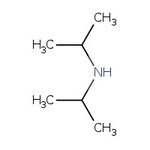Search Thermo Fisher Scientific
Diisopropylamine, 99+%, Thermo Scientific Chemicals



Diisopropylamine, 99+%, Thermo Scientific Chemicals
Chemical Identifiers
Specifications
Description
Diisopropylamine is used as a precursor to prepare lithium diisopropylamide and sulfenamides, which are used in rubber vulcanization. It is also involved in the synthesis of N,N-Diisopropylethylamine (Hünig's base) obtained by alkylation with diethyl sulfate. Diisopropylammonium bromide is a bromide salt of DIPA used as an inert alternative to barium titanate. It is widely used as solvent as well as an intermediate in the the synthesis of pharmaceuticals, dyes, mineral flotation agents and emulsifiers.
This Thermo Scientific Chemicals brand product was originally part of the Alfa Aesar product portfolio. Some documentation and label information may refer to the legacy brand. The original Alfa Aesar product / item code or SKU reference has not changed as a part of the brand transition to Thermo Scientific Chemicals.
Diisopropylamine is used as a precursor to prepare lithium diisopropylamide and sulfenamides, which are used in rubber vulcanization. It is also involved in the synthesis of N,N-Diisopropylethylamine (Hünig′s base) obtained by alkylation with diethyl sulfate. Diisopropylammonium bromide is a bromide salt of DIPA used as an inert alternative to barium titanate. It is widely used as solvent as well as an intermediate in the the synthesis of pharmaceuticals, dyes, mineral flotation agents and emulsifiers.
Solubility
Miscible with water.
Notes
Air sensitive. Keep container tightly closed in a dry and well-ventilated place. Incompatible with strong acids, strong bases, strong oxidizing agents and plastics.
Figures
Documents & Downloads
Certificates
Frequently asked questions (FAQs)
Citations & References
Safety and Handling
Classification of the substance or mixture
CLP classification - Regulation(EC) No 1272/2008
Label Elements
Signal Word
Danger
Hazard Statements
H302 - Harmful if swallowed
H314 - Causes severe skin burns and eye damage
H331 - Toxic if inhaled
H335 - May cause respiratory irritation
Physical Hazards
H225 - Highly flammable liquid and vapor
Precautionary Statements
P210 - Keep away from heat, hot surfaces, sparks, open flames and other ignition sources. No smoking
P280 - Wear protective gloves/protective clothing/eye protection/face protection
P301 + P330 + P331 - IF SWALLOWED: Rinse mouth. Do NOT induce vomiting
P303 + P361 + P353 - IF ON SKIN (or hair): Take off immediately all contaminated clothing. Rinse skin with water or shower
P305 + P351 + P338 - IF IN EYES: Rinse cautiously with water for several minutes. Remove contact lenses, if present and easy to do. Continue rinsing
P310 - Immediately call a POISON CENTER or doctor/physician